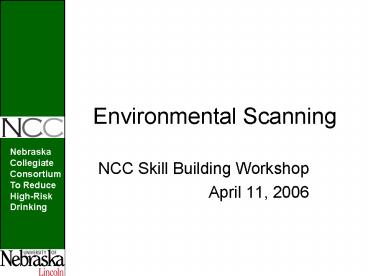Environmental Scanning - PowerPoint PPT Presentation
1 / 22
Title:
Environmental Scanning
Description:
College Alcohol Risk Assessment Guide (Ryan, Cothurst, Segars, 1997) ... Banning alcohol on campus, even at faculty and alumni events. Nebraska. Collegiate. Consortium ... – PowerPoint PPT presentation
Number of Views:488
Avg rating:3.0/5.0
Title: Environmental Scanning
1
Environmental Scanning
- NCC Skill Building Workshop
- April 11, 2006
2
College Alcohol Personality Survey
- Combination of content taken from two documents
- College Alcohol Risk Assessment Guide (Ryan,
Cothurst, Segars, 1997) - A Call To Action Changing the Culture of
Drinking at U.S. Colleges (Task Force of the
National Advisory Council on Alcohol Abuse and
Alcoholism, 2000)
3
College Alcohol Personality Survey
- Method of detecting size and magnitude of the
problem when combined with student self-report
data - Expose contributing factors
- Maximize resources by focusing efforts
strategically - Uncover potential coalition partners
4
Neighborhood Party Complaints
5
Party Complaints by Time of Day
6
Party Complaints by Day of Week
7
Last Drink Data
8
College Alcohol Personality Survey Part One
- Campus Life
- Alcohol Issues
- Alcohol Availability and Promotion
- Media Environment
- Whats on the Walls
- Student Neighborhood Environments
- Working Environments
- Neighborhoods Around Campus
- Parties and Events
- Campus Bookstores
- What Else?
- Party Risk Assessment
- On-Premise Alcohol Outlet Risk Assessment
9
College Alcohol Personality SurveyPart Two
- Identifying Ongoing Alcohol-Related Problems
- How do you know?
- Is there data to substantiate your perception of
the problem? - Is the data collected routinely or is it based on
anecdotal evidence?
10
College Alcohol Personality SurveyPart Three
- Contributing Factors
- How do you know?
- Is there data to substantiate your perception of
the problem? - Is the data routinely collected or is it based on
anecdotal evidence?
11
College Alcohol Personality SurveyExercise
- Individually complete both the Campus Life and
Alcohol Issues sections of the CAPS Part One. - As a team, discuss each individual response.
Compare and contrast differing opinions among
team members. - Reach consensus regarding the team impression
for both the Campus Life and Alcohol Issues
sections of the CAPS Part One.
12
Prevention Activities
13
NIAAA Task Force Report Overview
- The Task Force on College Drinking
- 1999 NIAAA and NIH designated task force charged
with developing a national agenda on college
student drinking. - Two panels created the Panel on Contexts and
Consequences and the Panel on Prevention and
Treatment. - Panels comprised of faculty, staff, students,
administrators, and other ATOD professionals. - Each panel asked to submit a report reviewing the
scientific literature, identified gaps in
knowledge, and recommended promising directions
for future research.
14
NIAAA Task Force Report Overview
- Tier 1 Evidence of effectiveness among
college students - Tier 2 Evidence of success with general
populations that could be applied to college
environments - Tier 3 Evidence of logical and theoretical
promise, but require more comprehensive
evaluation. - Tier 4 Evidence of ineffectiveness
15
NIAAA Task Force Report Overview
- Tier 1 Evidence of Effectiveness Among
College Students - Combining cognitive-behavioral skills with norms
clarification and motivational enhancement
interventions - Offering brief motivational enhancement
interventions - Challenging alcohol expectancies
16
NIAAA Task Force Report Overview
- Tier 2 Evidence of Success with General
Populations That Could Applied to
College Environments - Increased enforcement of minimum drinking age
laws - Implementation, increased publicity, and
enforcement of other laws to reduce alcohol
impaired driving - Restrictions on density of retail alcohol outlets
- Increased price and excise taxes on alcoholic
beverages - Responsible beverage service policies (social and
commercial) - The formation of a campus and community coalition
- involving all major stakeholders may be critical
in order to - implement these strategies.
17
NIAAA Task Force Report Overview
- Tier 3 Evidence of Logical and Theoretical
Promise, but
Require More Comprehensive Evaluation - Reinstating Friday classes and exams and Saturday
morning classes - Implementing alcohol-free, expanded late-night
student activities - Eliminating keg parties on campus
- Employing older, salaried resident assistants or
hiring adults - Further controlling or eliminating alcohol at
sports events and prohibiting tailgating - Refusing sponsorship gifts from the alcohol
industry - Banning alcohol on campus, even at faculty and
alumni events
18
NIAAA Task Force Report Overview
- Tier 3 Evidence of Logical and Theoretical
Promise, but
Require More Comprehensive Evaluation - Increasing enforcement at campus-based events
that serve alcohol - Increasing publicity about enforcement of
underage drinking laws - Consistently enforcing disciplinary actions
associated with policy violations - Conducting marketing campaigns to correct student
misperceptions of alcohol use - Providing safe rides programs
- Regulating happy hours and sales
- Informing new students and their parents about
alcohol policies and penalties before arrival and
during orientation
19
NIAAA Task Force Report Overview
- Tier 4 Evidence of Ineffectiveness
- Informational, knowledge-based, or values
clarification interventions about alcohol and the
problems related to its excessive use (when used
alone) - Provision of blood alcohol content feedback to
students
20
NIAAA Checklist
21
Discussion Questions
- Using your inventory of current prevention
efforts and NIAAA checklist, please discuss the
following questions with your team - Do your current prevention efforts incorporate
evidence-based strategies? Which ones? - Are staff time and resources currently being
spent on activities that show little or no
evidence of effectiveness according to the
research literature? How much? - Are your current efforts aimed at creating
environmental change?
22
Resources
- The College Alcohol Personality Survey
www.faceproject.org - The NIAAA Task Force Report www.collegedrinkingp
revention.gov - The Higher Education Center for Alcohol and Other
Drug Prevention www.edc.org/hec - NU Directions Campus/Community Coalition
www.nudirections.org - Nebraska Collegiate Consortium to Reduce High
Risk Drinking www.nebconsortium.org































